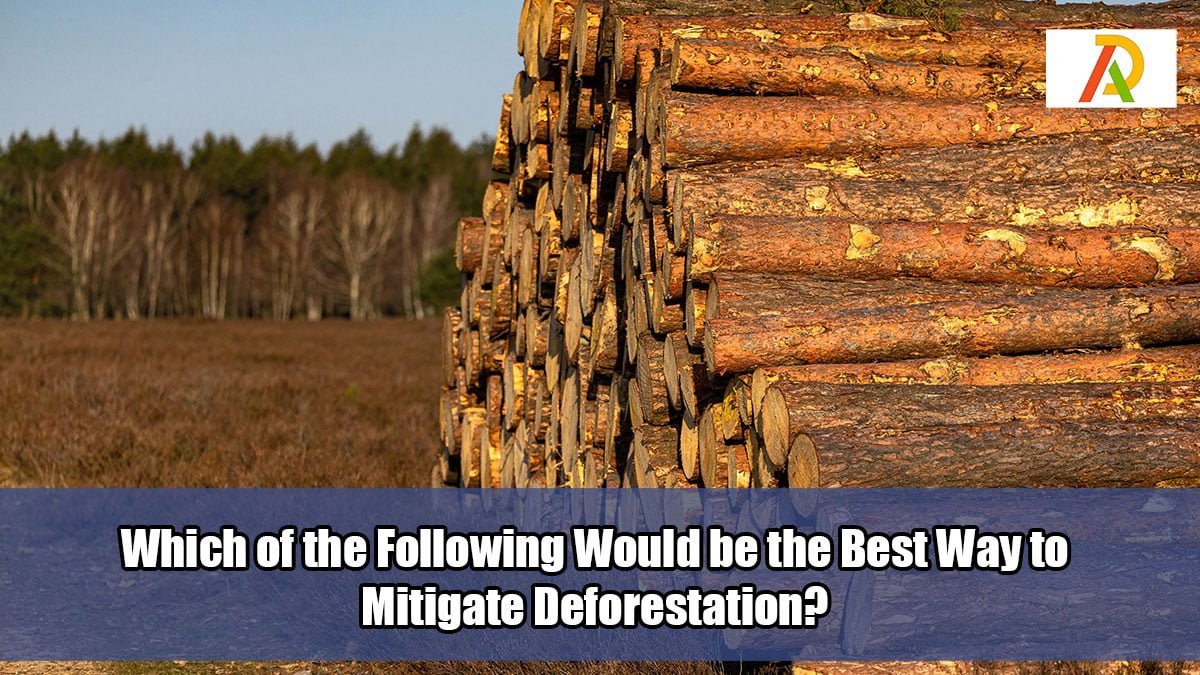Which of the Following Would be the Best Way to Mitigate Deforestation?

Deforestation is one of the most pressing environmental issues we face today. It not only destroys habitats and contributes to biodiversity loss but also exacerbates climate change. Hence, it is crucial to explore the best ways to mitigate deforestation and protect our planet’s lungs – the forests.
Promoting Sustainable Forest Management: A Key Strategy to Combat Deforestation
One of the most effective and long-term solutions to mitigate the devastating effects of deforestation lies in the widespread adoption and implementation of sustainable forest management practices. This approach goes beyond simply halting tree felling; it involves a holistic and responsible use of forest resources, carefully balancing our present needs with the imperative to preserve the health and vitality of these ecosystems for future generations. Sustainable forest management is a philosophy and a set of techniques that prioritize the long-term health and productivity of forests, recognizing their intrinsic value and the crucial role they play in the global ecosystem. Key components of this strategy include well-defined policies and practices such as selective logging, a method where only mature or specific trees are carefully harvested, minimizing disruption to the surrounding forest and allowing for natural regeneration. Reforestation efforts are equally vital, ensuring that harvested areas are promptly and effectively replanted with native tree species, restoring biodiversity and promoting the long-term resilience of the forest. Sustainable forest management also encompasses practices that protect forests from diseases, pests, and uncontrolled fires, all of which can contribute significantly to deforestation and habitat loss. By embracing sustainable forest management, we can ensure that forests continue to provide essential resources and ecological services while actively combating the destructive forces of deforestation.
Strengthening Legal Measures Against Illegal Logging: A Crucial Step in Deforestation Prevention
Illegal logging represents a significant and pervasive threat to forests worldwide, acting as a major catalyst for deforestation and its associated environmental and economic consequences. To effectively combat deforestation, it is imperative to strengthen legal measures and enforcement efforts aimed at curbing these illicit activities. These measures must encompass a multi-faceted approach, including not only the establishment of robust and comprehensive legal frameworks but also the diligent and consistent enforcement of existing laws. This involves ensuring that those who engage in illegal logging are held accountable for their actions, with penalties that are sufficiently harsh and serve as a genuine deterrent. Furthermore, effective monitoring and surveillance of forest areas are essential to detect and prevent illegal logging activities. This can be achieved through a combination of on-the-ground patrols, the use of technology such as satellite imagery and remote sensing, and collaboration with local communities who often possess invaluable knowledge of their surrounding forests. By creating a strong legal deterrent and bolstering enforcement capabilities, we can significantly reduce the incidence of illegal logging and, in turn, mitigate the rate of deforestation, protecting these vital ecosystems for the benefit of all.
Enhancing Education and Awareness: Empowering Action Against Deforestation
Educating the public about the far-reaching and devastating impacts of deforestation and fostering a deeper understanding of the vital importance of forests is a cornerstone of any effective strategy to mitigate deforestation. Raising awareness about the ecological significance of forests, their role in maintaining global climate balance, and the consequences of their destruction is crucial in galvanizing public support for conservation efforts. When individuals and communities are empowered with knowledge about the vital functions forests perform – from regulating water cycles and providing habitat for biodiversity to absorbing carbon dioxide and mitigating climate change – they are more likely to actively engage in and support initiatives aimed at forest protection and sustainable management. This educational outreach should target a wide range of audiences, including schools, communities, policymakers, and businesses, employing diverse communication methods such as public campaigns, educational programs, and community engagement initiatives. By fostering a sense of environmental responsibility and promoting a culture of forest stewardship, we can empower individuals to make informed choices and take meaningful action to combat deforestation.
Implementing and Supporting Agroforestry: A Sustainable Alternative to Deforestation
Agroforestry, the innovative and sustainable practice of intentionally integrating trees and shrubs into farming systems, presents a powerful and promising tool in the global effort to mitigate deforestation. This approach offers a compelling alternative to traditional agricultural practices that often contribute to forest clearing and land degradation. Agroforestry systems provide farmers with diversified income sources, reducing their economic reliance on activities that lead to deforestation, such as clearing forests for agricultural expansion. By incorporating trees into their farms, farmers can generate revenue from timber, fruits, nuts, and other tree products, creating a more sustainable and resilient livelihood. Furthermore, agroforestry plays a crucial role in restoring degraded lands, improving soil health and fertility, enhancing biodiversity, and sequestering carbon. The integration of trees into agricultural landscapes helps to prevent soil erosion, improve water infiltration, and create a more balanced and productive ecosystem. Supporting and promoting agroforestry practices can significantly contribute to deforestation reduction while simultaneously enhancing agricultural sustainability and promoting rural development.
Encouraging Responsible Consumerism
Every individual can contribute to mitigating deforestation through responsible consumerism. By choosing products that are certified as sustainable or deforestation-free, consumers can drive demand for environmentally friendly practices. Additionally, reducing the consumption of products that drive deforestation, such as certain types of meat and palm oil, can also make a significant impact.
Also read more on India Govt. related:
- Discover the Power of Tafcop Portal: Simplify Your Aadhar Card Experience
- UIDAI’s Official Site: Authentic Aadhaar Updates
- How to block someone on tiktok
- how to vote lok sabha: A Guide for First-Time Voters
- How to change address in aadhar card
Investing in Reforestation Initiatives
Investing in reforestation initiatives is another key strategy to mitigate deforestation. By actively planting trees and restoring degraded forestlands, we can help offset the damage caused by deforestation. These initiatives also provide job opportunities, contributing to sustainable development.
Conclusion:
Multiple Approaches to Mitigate Deforestation There is no single solution to mitigate deforestation; rather, it requires a combination of strategies, including sustainable forest management, legal measures, education, agroforestry, responsible consumerism, and reforestation initiatives. Everyone, from individuals to governments and corporations, has a role to play in these efforts. By working together, we can mitigate deforestation and ensure our forests continue to thrive for generations to come. After all, the future of our planet depends on it.


